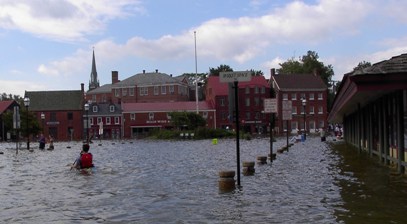- Causes of Future Sea Level Rise
- Elevation Maps
- Will we really lose all that land?
- Sea Level Rise Planning Maps
Coastal Flooding
Rising sea level inundates low-lying areas, converts wetlands to open water, erodes beaches, exacerbates flooding, and increases the salinity of estuaries and aquifers. Here are some reports that examine increased flooding. as sea level rises.

Annapolis the day after Hurricane Isabel |
Sea level rise can excacerbate all of the causes of coastal flooding.
- During hurricanes and severe northeasters, intense winds and low pressure cause water to pile up higher than normal, causing what is known as a storm surge. These surges are generally the source of the worst flooding. Rising sea level provides a higher base upon which storm surges build, and thereby increases the risk of severe flooding. Moreover, loss of wetlands from sea level rise can remove a storm surge buffer.
- Along the ocean coast, storm waves can destroy homes even if they are elevated above the storm water level. Sea level rise increases the risk of damging storm waves for two reasons: the higher water level provides a higher base for the waves so they are able to strike structures that might otherwise be elevated above the waves; and shore erosion causes by sea level rise allows the waves to strike farther inland
- Extreme high tides during new and full moons can flood areas that are above the normal high tide. Rising sea level elevates all of the tides, allowing spring tide flooding to reach farther inland.
- Low-lying coastal areas often flood during severe thunderstorms because they drain very slowly. Rising sea level further slows the rate at which low-lying areas flood.
- Basements flood in low-lying areas because of high water tables. Sea level rise increases the elevation of coastal water tables, and can make some basements unusable.
- Finally, the most catastrophic flooding of all occurs when dikes and other flood control facilities fail or become overtopped during a severe storm. Dikes designed for a given sea level can fail if sea level rise allows higher water levels to overtop them. The flooding of New Orleans during Hurricane Katrina appears to have resulted because a key dike along the Industrial Canal was designed for the sea level of 1929, which was a few feet lower than sea level today in New Orleans.
Reports and other products
- Projected Impact of Relative Sea Level Rise on the National Flood Insurance Program - originally published by the Federal Emergency Management Agency, Flood Insurance Administration (1991). This report estimates the impact of a 1-foot and a 3-foot rise in sea level on flood insurance rates. The report concludes that rising sea level would not affect the financial solvency of the flood insurance program because premiums would rise to cover increased claims.
- Greenhouse Effect, Sea Level Rise, and Coastal Drainage Systems - Journal of Water Resources Planning and Management, Vol. 113, No. 2., March 1987. This study quantified the increased rainwater flooding from reduced drainage as sea level rises. The report estimated the cost of including a 1-foot rise in sea level in planned near-term reconstruction of urban drainage systems, as well as a subsequent retrofit.
- Coastal Flooding, Floodplains, and Coastal Zone Management (18 pp, 6.4MB) explains what experts at the National Oceanic and Atmospheric Administration think about the impact of sea level rise on coastal floodplains. The article was a chapter in the Bush Administration's official literature review of the impacts of sea level rise entitled Coastal Sensitivity to Sea Level Rise: A Focus on the Mid-Atlantic Region. - U.S. Climate Change Science Program (2009) The chapter does not quantify flood risks from sea level rise.
- Galveston Bay Case Study by Stephen P Leatherman (1984) in Greenhouse Effect and Sea Level Rise: A Challenge for this Generation. Uses a storm surge model to estimate flood levels around Galveston Bay as sea level rises. Also estimates annual flood damages.
- Charleston Case Study by Tim Kana et al. (1984) in Greenhouse Effect and Sea Level Rise: A Challenge for this Generation. Also estimates annual flood damages.
- Implications of Sea Level Rise for Hazardous Waste Sites in Coastal Floodplains (PDF, 20 pp., 440 kb) – Timothy J. Flynn, Stuart G. Walesh, James G. Titus, and Michael C. Barth. In Greenhouse Effect and Sea Level Rise: A Challenge for this Generation.
